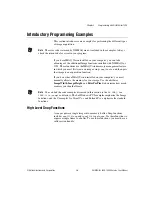
©
National Instruments Corporation
3-1
NI-IMAQ for IEEE-1394 Cameras User Manual
3
Programming with
NI-IMAQ for 1394
This chapter contains an overview of the NI-IMAQ for 1394 library,
a description of the programming flow of NI-IMAQ for 1394, and
programming examples. Flowcharts are included for the following
operations: snap, grab, and sequence.
Introduction
The NI-IMAQ for 1394 application programming interface (API) is
divided into two groups—high-level functions and low-level functions.
With the high-level functions, you can write programs quickly without
having to learn the details of the low-level API and driver. The low-level
functions give you finer granularity and control over your image
acquisition process, but you must understand the API and driver in greater
detail.
Note
The high-level functions call low-level functions and use certain attributes that are
listed in the high-level function description in the NI-IMAQ for 1394 Function Reference
online help. Changing the value of these attributes while using low-level functions will
affect the operation of the high-level functions.
High-Level Functions
The high-level function set supports three basic types of image acquisition:
•
Snap
acquires a single frame to a buffer.
•
Grab
performs an acquisition that loops continually on one buffer; you
obtain a copy of the acquisition buffer by
grabbing
a copy to a separate
buffer that can be used for analysis.
•
Sequence
performs an acquisition that acquires a specified number of
buffers, then stops.
The high-level function set also allows triggered acquisitions.
















































